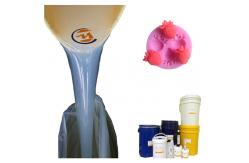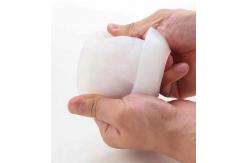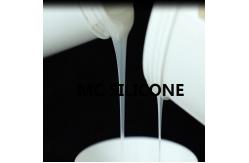Translucent Liquid Silicone Moulding Rubber Flowable Silicone Addition Cure
|
|
Casting Liquid Silicone Rubber Moulding Silicone Platinum Cure 25 A
what is RTV-2 platinum cured liquid silicone rubber Two-component addition type silicone rubber Silicone Rubber is a two-part, platinum-catalyzed, liquid silicone system that cures (RTV) to flexible elastomer. The polymerization can be accelerated by heat. The silicone components are delivered as low viscosity liquids, which once mixed and cured into a translucent, elastic and resistant material.
what are the Advantages of RTV2 platinum cure silicone rubber
#High Tear Strength: RTV2 platinum cure silicone rubber has a high tear strength,
making it ideal for making complex molds that require multiple
demolding cycles. #Easy Release: RTV2 platinum cure silicone rubber has excellent release properties, which means that the mold or casting can be easily removed from the mold without causing damage to the final product.
#Non-Toxic and Skin Safe: RTV2 platinum cure silicone rubber is non-toxic and skin safe, making it safe for use in applications that come into contact with skin or food.
what are the Applications of RTV2 platinum cure silicone rubber
1.RTV2 platinum cure silicone rubber is commonly used for making molds for industrial parts,various materials such as resins, plaster, and concrete, decorative objects.
2.Food and Confectionery: RTV2 platinum cure silicone rubber is used in the food and confectionery industry for creating molds for chocolates, candies, and other food items.
3.Special Effects: RTV2 platinum cure silicone rubber is used in the film and entertainment industry for creating special effects and prosthetics.
Processing and Instructions of Addition Cure Silicones 1. Mixing the two components According the mixing ration 10:1 or 1:1 weighting A and B, the two
components may be thoroughly mixed either by hand or using a
low-speed electric to minimize the degassing of bubbles and to
avoid any temperature increase. Note: It is also possible to use a
special mixing and dispensing machine for the silicone components,
further information is available upon request. 2. Moulding The mixture should be degassed preferably at 30 to 50 mbar to
eliminate any entrapped air. If a dispensing machine is used, the
two components are degassed separately prior to mixing. The
silicone mixture expands to 3-4 times of its initial volume and
bubbles rise to the surface. The bubbles progressively disappear
and the mixture returns to its initial volume after 5 to 10
minutes. Wait a few minutes to complete the degassing and then
flash the vacuum. The silicone is ready for pouring, either by
gravity or under low pressure. Note: Flashing the vacuum once or twice accelerates the degassing.
It is recommended to use a container with a high diameter/height
ratio (3 to 4 times of the initial volume) 3. Polymerisation The curing may be slowed down at lower temperature or accelerated
by applying heat.
Note: Contamination from sulfur (e.g., sulfur-based clay), amines, tin
compounds, cured polyester resin, some paints and some silicone
rubbers may inhibit surface cure of platinum-cured rubbers. Apply a release agent, Although not usually necessary, a release agent will make demolding easier when casting into most surfaces. Packaging of RTV-2 platinum cured liquid silicone rubber 20kg per drum, 200kg per drum
Storage and shelf life MC Silicone MCPLA -L Series should be used within 12 months
from the manufacturing date. Beyond this date, MC silicone no
longer guarantees the products confirms with the sales
Specification. In order to preserve best properties it is
recommended to follow strictly the following guild lines:
FAQ of RTV2 Platinum Cured Liquid Silicone Rubber Q1: Why the curing time of platinum silicone varies in environment
with different temperature ? Platinum (addition) cured silicone rubber,Which with platinum
catalyst and uses heat to transform from liquid to solid rubber.
Therefore, platinum cured silicone rubber is sensitive to
temperature, platinum systems are often cured quickly with heat, although they can also be formulated to cure at low temperatures
and room temperature. Q2:why the bottom and sides of platinum silicone molds are
stillgummy? platinum silicone rubber requires accurate and careful mixing. The
material must be mixed thoroughly for at least 3~5 minutes. make
sure to scrape the container sides, bottom, and corners as you mix. Q3: Why the platinum silicone rubber do not cure? Platinum-cure silicone rubbers are critically sensitive to some
materials and will not cure under any circumstances when exposed.
like the materials below: #Natural rubbers vulcanized with sulfur #RTV elastomer is catalyzed with metal salts, e. G. Tin compounds #Epoxy catalyzed with amines #Certain organic solvents, such as Ketones, alcohols, etc. Contact: |
||||||||||||||||||||||||||||||||||||
| Product Tags: Liquid Silicone Moulding Rubber Flowable Silicone Addition Cure Flowable Silicone Moulding Rubber | ||||||||||||||||||||||||||||||||||||
|
|
High Viscosity Platinum Silicone Rubber For Angel Wings Silicone Mold Viscosity 7000-9000 cps Mix ratio 1 1 |
|
|
Platinum Silicone Rubber For Mermaid Tail Sugar Art Cake Decoration Silicone Mold |
|
|
Translucent Platinum Silicone Rubber For Starfish Shell Resin Silicone Mold |
|
|
0 Shore A Platinum Silicone Rubber For Cream-pointed Silicone Mold |
|
|
10 Shore A Platinum Silicone Rubber for Rose Resin Silicone Mold 30-40 Minutes Working Time 3.8-4.0 Mpa Tensile Strength |
|
|
10 Shore A Platinum Silicone Rubber for Rose Silicone Mold High Tear Strength 15-17 N/mm and Viscosity 7000-9000 cps |



